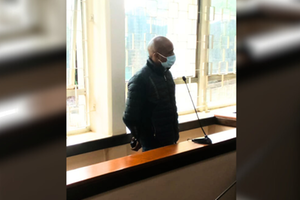Low antenatal visits blamed for surge in maternal deaths

What you need to know:
- Post-partum haemorrhage (PPH) still remains one of the leading causes of deaths among women during or after delivery.
- A number of counties in the Western and Nyanza have continued to record PPH cases, with some still recording a higher number of deaths.
Mr Eddy Magawa stares at his daughter-in-law's freshly covered grave while a tear drops down his cheeks. A couple of weeks ago, Mercyline Atieno had been well and full of life but little did he know that Ms Atieno, who was nine months pregnant, would end up dying while bringing forth new life.
On October 10, 24-year-old Atieno was accompanied by her mother-in- law to Ahero Sub-County Hospital, where she was to deliver her first born child. A few hours before she went into labour, Ms Atieno had breathing difficulty and had to be rushed to the hospital, where doctors prescribed drugs which she had to get from a nearby chemist.
She then travelled back home but a few hours later, Ms Atieno went back to the hospital after her contractions began. Her family was called back to the hospital the next morning by 3am on learning that the new mother was in a critical condition.
“On arrival, we were informed that Atieno had delivered a baby boy; however, she had succumbed to severe bleeding,” says Mr Magawa.
Severe bleeding
He says they learned from other nursing women that Ms Atieno’s placenta took time to come out after delivery, subjecting her to severe bleeding.
“One woman told us that while bleeding, Atieno begged the health workers to attend to her but they could hear none of it,” he says amid tears.
“We also asked the hospital for her post-mortem results but they keep taking us round in circles,” says Mr Magawa.
While the family is still demanding justice, Dr George Rae, CEO Jaramogi Oginga Odinga Teaching and Referral Hospital (JOOTRH), confirms that post-partum haemorrhage (PPH) still remains one of the leading causes of deaths among women during or after delivery. Dr Rae defines PPH as excessive bleeding after delivery leading to loss of more than 500 mls after vaginal delivery and more than 1,000 mls following a cesarean-section.
The internal bleeding may also occur between zero to three months after birth and if not well taken care of may lead to death.
According to Dr Rae,JOOTRH, which serves as the major referral centre in the Western region, has recorded 109 cases of PPH since the year began, with two confirmed fatalities. He notes that most cases are often brought to the facility when in a critical condition thus contributing to more deaths.
A number of counties in the Western and Nyanza have continued to record PPH cases, with some still recording a higher number of deaths.
Kisumu Health Director Fredrick Oluoch says the county has recorded 15 PPH deaths from January to December. “The cases were higher in 2019 when we recorded 52 deaths. In 2020, the number reduced to 34,” says Mr Oluoch, who blames the mortalities to low antenatal care (ANC) visits and blood shortages at the regional referral hospital.
He states that ANC visits are often poorly attended, with only 48 per cent of expectant mothers visiting hospitals. “This can only mean that they are not monitored and miss out on the individual birth plan, which prepares them for the delivery date.”
In Kakamega County, Dr Collins Matemba, the Health Committee chief executive, says in 2020, 40 per cent of maternal deaths were a result of PPH.
He notes that one of the major challenges in the county is lack of information on the birth complications attributed to loss of blood.
He says most women in the region do not attend ANC, with the fourth visit dropping to 53 per cent in 2020. He adds that only 50 per cent of women in the county are aware of PPH.
Homa Bay Director Preventive and Promotive Health Adel Ottoman says the county has recorded 164 cases of PPH since January and 14 deaths.
In 2020, the county recorded 224 cases of PPH and 13 lives were lost during the treatment process.
In an effort to prevent the untimely deaths during childbirth, the counties are working on various strategies.
In Kisumu County, the Health department has ensured the referral hospital is well equipped with constant supply of blood and a number of theatres have been constructed in various sub-county facilities with constant blood supply.
There is also constant follow-up of expectant mothers by community health workers to ensure they attend antenatal clinics.
"We are also privileged to have cabetoxin, which although is still rare in the country, plays a major role in preventing PPH before and after birth," says Mr Oluoch.
In Kakamega County, there are free ambulance services to transport expectant mothers for referral services, and the Oparanya Care, which ensures women deliver in health facilities, undergo all immunisations and access family planning after birth.
“We have also ensured constant supply of the drugs required for PPH treatment, which include oxytocin, misoprotol and tanexamic acid in most facilities,” says Dr Matemba.
The World Health Organization estimates that obstetric haemorrhage is the leading cause of maternal mortality accounting for 127,000 deaths annually.
Postpartum haemorrhage is the most common type of obstetric haemorrhage and it accounts for 14 million cases that occur each year.
In order to end the untimely deaths of the expectant women, health experts advise women to take a well-balanced diet, attend all the four clinical visits and visit the nearest health facility in case of complications.
“It is also important for an expectant woman to visit a health facility during delivery to ensure health workers look out for all the danger signs. This goes a long way in ensuring no life is lost during childbirth,” says Dr Rae.





